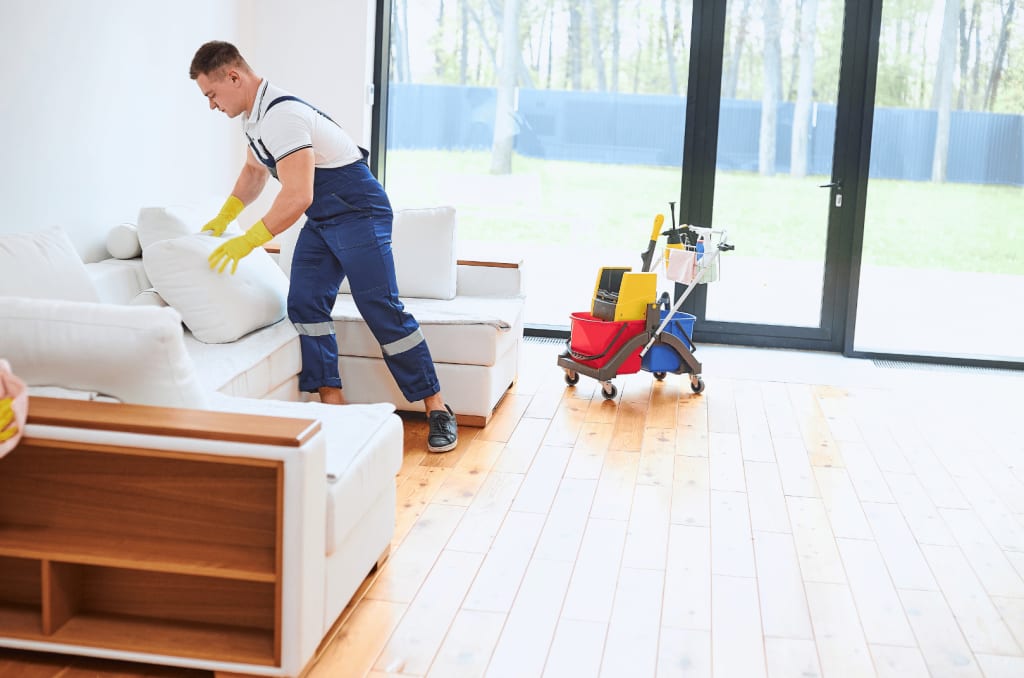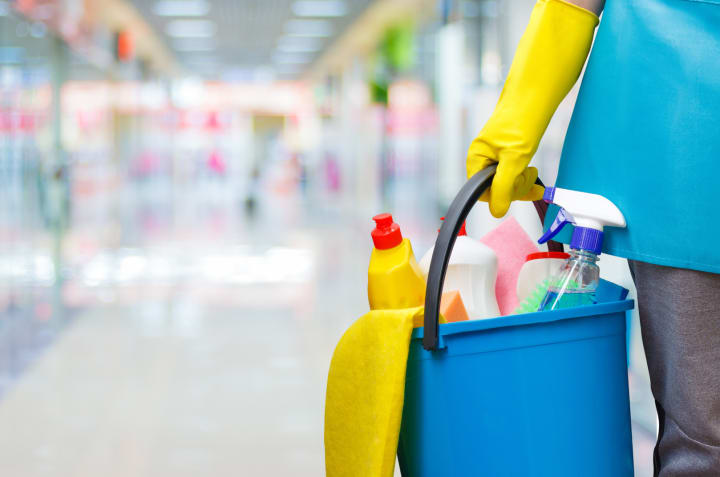Leather Sofa Cleaning: A Guide to Keeping Your Furniture Pristine
Maintaining the Elegance: A Deeper Dive into Leather Sofa Care in Singapore

When it comes to home decor, leather sofas are an undisputed choice. They exude elegance, style, and durability. However, over time, these luxurious pieces of furniture can accumulate dirt, stains, and grime, dulling their luster. Regular cleaning and maintenance are essential to ensure that your leather sofa retains its beauty and longevity. In this article, we will guide you through the process of leather sofa cleaning in Singapore, providing you with expert tips and insights to help keep your furniture pristine.
Understanding Leather Sofas
Types of Leather Used in Sofas
Leather sofas can be made from various types of leather, each possessing its unique set of characteristics and cleaning needs:
1. Full-Grain Leather: The highest quality of leather that is durable and has a unique, natural appearance. It is breathable and develops a natural patina over time. However, it may show imperfections like scars or stretch marks.
2. Top-Grain Leather: A high-quality leather that is most commonly used for furniture. It is sanded to remove imperfections and is more uniform in appearance. It doesn't develop the same patina over time but is easier to maintain than full-grain.
3. Split Leather: More affordable but lacks the durability and unique characteristics of top-grain and full-grain leather. It's often used in less wear-prone parts of the sofa.
4. Bonded Leather: Made from remnants of the hide bonded together, creating a fabric that is painted to look like real leather. It's an affordable choice but lacks the strength or durability of genuine leather.
5. Bi-Cast Leather: Similar to bonded leather, but coated with a layer of polyurethane and embossed to mimic grain patterns. It's less breathable and can crack over time.
6. Faux Leather: A fabric base coated in plastic or vinyl that is vegan-friendly and comes in a variety of colors and styles. Although not as durable or breathable as real leather, it is a popular choice due to its lower cost and ease of maintenance.
Advantages of Leather Sofas
Leather sofas offer several advantages over other upholstery materials. They are:
1. Highly Durable: Less likely to tear, crack, or peel compared to other fabrics.
2. Easy to Clean: Excellent for people with allergies as leather doesn't accumulate dust and allergens.
3. Age Gracefully: Leather, especially full-grain leather, develops a unique patina that adds character to the sofa.
4. Luxurious Appearance: Enhances the aesthetic appeal of any room.
Challenges of Leather Sofas
Despite their benefits, leather sofas require regular maintenance to prevent drying, cracking, and discoloration. They also have a few challenges:
1. Cost: Leather sofas are typically more expensive than their fabric counterparts.
2. Sensitive to Temperature: Leather can feel cold in colder months, and it may feel hot and sticky in a warm environment.
3. Requires Regular Maintenance: Regular conditioning is needed to prevent the leather from drying out and cracking.
4. Prone to Scratches: May not be the best choice for households with pets or young children.
5. Color Fading: Over time, the color of leather can fade, especially if exposed to sunlight.
6. Not Vegan-Friendly: Real leather is made from animal hide.
2. Preparing for Cleaning

Gathering the Necessary Supplies
Before you embark on the cleaning journey, ensure you gather all necessary supplies: a vacuum cleaner with a brush attachment, distilled water, mild soap or leather cleaner, soft microfiber cloths, a soft-bristle brush, and a high-quality leather conditioner. This preparation step is crucial for a smooth and efficient cleaning process.
Checking the Manufacturer's Instructions
Always adhere to the cleaning guidelines provided by your sofa's manufacturer. These instructions, typically found on tags, are specifically tailored for the type of leather used in your sofa and can prevent unintentional damage.
3. Cleaning Products and Tools

Choosing the Right Cleaning Products
When selecting a cleaner, choose a mild soap or a pH-neutral leather cleaner designed specifically for leather furniture. Harsh chemicals and abrasive household cleaners can detrimentally affect the leather's surface and should be avoided.
Using Distilled Water
When preparing cleaning solutions, it is recommended to use distilled water instead of tap water. Tap water may contain minerals and impurities that can leave stains or residue on the leather.
4. Cleaning Process Step-by-Step
Vacuuming the Sofa : Begin your cleaning process by vacuuming your leather sofa, using the brush attachment to remove loose dirt, dust, and debris. Be sure to reach into the crevices and corners where dirt often hides.
Testing the Cleaning Product : Before you commence the full cleaning process, test your chosen cleaner or soap on a discreet area of the sofa. This ensures that the product does not cause an adverse reaction or discoloration.
Cleaning the Leather Surface : To clean the surface, dampen a soft microfiber cloth with your cleaning solution and gently wipe the entire surface of the sofa. Excessive moisture and aggressive rubbing can harm the leather and should be avoided.
Removing Stubborn Stains : For stubborn stains, consider creating a mild cleaning solution by mixing equal parts distilled water and vinegar. Apply this solution using a soft cloth, blotting the stain gently. Vigorous scrubbing can cause further damage and should be avoided.
Drying the Leather : For stubborn stains, consider creating a mild cleaning solution by mixing equal parts distilled water and vinegar. Apply this solution using a soft cloth, blotting the stain gently. Vigorous scrubbing can cause further damage and should be avoided.
5. Dealing with Stains and Spills
Immediate Response to Spills : Accidents happen, but it's how you deal with them that matters. In the event of a spill, immediately blot the liquid with a clean cloth. Avoid wiping or rubbing, as this could spread the spill and exacerbate the damage.
Removing Greasy Stains : To tackle greasy stains, lightly dust some baking soda over the affected area and leave it for a few hours. The baking soda will absorb the grease, after which you can gently brush it off and wipe away the residue with a soft cloth.
6. Conditioning and Protecting Your Leather Sofa

Importance of Leather Conditioning
Conditioning is akin to moisturizing your skin – it's a crucial step to keep your leather sofa supple and lustrous. Leather is a natural material that can lose its natural oils and moisture over time. This can lead to the leather becoming dry and brittle, eventually leading to cracks and damages.
Maintains Moisture: Regularly conditioning your leather sofa keeps it well-hydrated. This prevents it from drying out and cracking, which is often the most common cause of premature wear and tear in leather furniture.
Enhances Sheen: Conditioning doesn't just preserve your sofa; it can also enhance the natural sheen of your leather. High-quality conditioners often contain mild cleaning agents that can restore the lost shine of your sofa, reviving its grandeur and aesthetic appeal.
Prolongs Lifespan: Conditioning significantly extends the lifespan of your leather sofa. By replenishing lost oils and locking in the necessary moisture, conditioners prevent the onset of wear and tear, helping your sofa look new for longer.
Protection from Stains: Conditioning your sofa creates a protective barrier on the leather's surface, making it more resistant to stains and spillages. This can make your regular cleaning tasks simpler and less time-consuming.
Choosing a Leather Conditioner
With a myriad of leather conditioners available in the market, it's crucial to select a product that aligns with the type of leather your sofa is made of.
Compatibility: Ensure that the conditioner you choose is suitable for the type of leather your sofa has. Full-grain and top-grain leather may require different conditioners than bonded or faux leather. Always refer to the product's label for details.
Test Before Use: Just like with any cleaning product, it's a good practice to do a patch test with the conditioner on an inconspicuous part of your sofa. This will allow you to make sure the product does not discolor or adversely affect the leather.
Frequency of Use: Depending on your living environment and the type of leather, the frequency of conditioning can vary. Typically, conditioning your sofa every 6-12 months is recommended. However, if the sofa is exposed to factors such as dry climate, air conditioning, or direct sunlight, it might need more frequent conditioning.
Application: Apply the conditioner as per the manufacturer's instructions, typically using a soft cloth or sponge. Ensure that you work the conditioner into the leather in a circular motion, much like applying lotion to skin. Avoid over-applying the product, as it might leave the sofa feeling greasy.
Remember, proper care can significantly extend the life of your leather sofa. By conditioning your sofa regularly, you not only preserve its quality and appearance but also get the most out of your investment.
7. Regular Maintenance Tips
Avoiding Direct Sunlight: Exposure to direct sunlight can be detrimental to your leather sofa. Prolonged sunlight exposure can cause the leather to fade, and become brittle, which can lead to cracking. Consider the following to prevent this:
Positioning: Place your leather sofa in a part of the room that does not receive direct sunlight. This could be a corner or an area that is usually shadowed by other pieces of furniture or interior structures.
Window Treatments: Use window treatments, such as curtains, blinds, or even tinted window glass, to reduce the intensity of sunlight coming into the room.
Coverings: If repositioning the sofa or adding window treatments is not possible, consider using a throw blanket or a sofa cover during the hours of intense sunlight.
Dusting and Vacuuming
Just like any other piece of furniture, leather sofas also accumulate dust and debris over time, which can seep into the crevices and cause wear and tear. Here's how to prevent it:
Routine Dusting: Make it a habit to dust your leather sofa with a soft, dry cloth at least once a week. This will help to prevent dust build-up.
Vacuuming: Use a vacuum cleaner with a soft brush attachment to remove dust and debris from hard-to-reach crevices. Remember to vacuum under the cushions and in the corners of the sofa where dust can accumulate.
Regular Wipe Down
Apart from dusting and vacuuming, giving your sofa a regular wipe down can also help to maintain its pristine look:
Gentle Cleaning: Use a damp cloth to wipe down your sofa regularly. This will not only remove dust and minor stains but will also prevent any accumulation of grime or body oils that can damage the leather over time.
Drying: After wiping, ensure that the leather is dry by using a soft dry cloth. Leaving the leather damp can cause water stains or even lead to mildew formation.
By following these regular maintenance tips, you can ensure that your leather sofa retains its aesthetic appeal and lasts for years to come.
8. Hiring Professional Leather Sofa Cleaners

Benefits of Professional Cleaning
If you're unsure about cleaning your leather sofa or if it requires deep cleaning, consider hiring professional leather sofa cleaners. They have the expertise and specialized equipment to deliver excellent results. Professionals, like those at Cleanshades, a renowned service provider for leather sofa cleaning in Singapore, understand the unique care requirements of different types of leather. Their techniques not only ensure a thorough clean but also help to extend the lifespan of your sofa. For ultimate peace of mind and an immaculate leather sofa, entrust your cleaning needs to the professionals.
Finding a Reliable Cleaner
When hiring professional leather sofa cleaners, ensure they have a good reputation, experience in handling leather furniture, and positive customer reviews. Request quotes from multiple providers for comparison.
9. Common Mistakes to Avoid
Proper cleaning and maintenance of your leather sofa involve not only doing the right things but also avoiding common pitfalls that could potentially harm your furniture. Here are some of the typical mistakes to sidestep when it comes to leather sofa cleaning:
Using Harsh Cleaners : Harsh cleaning agents such as bleach or ammonia-based products should never be used on your leather sofa. These substances can damage the leather's surface, strip away its natural oils, cause discoloration, and even accelerate the aging process of the material. Always opt for gentle, leather-appropriate cleaners to ensure that your sofa stays in prime condition.
Over-Wetting the Leather : Leather is a natural, porous material, and as such, it can absorb a substantial amount of water. Excessive moisture during cleaning can lead to water stains and cause serious damage to the leather's structure, including swelling and warping. In extreme cases, over-wetting can even lead to mildew formation. Hence, always use minimal amounts of water or cleaning solution when cleaning your leather sofa. The key is to dampen the cloth, not soak it.
Neglecting Regular Maintenance : Leather sofas need more than sporadic cleaning; they require regular maintenance. This includes regular dusting, vacuuming, and immediate attention to spills and stains. Neglecting these tasks can lead to the accumulation of dirt and grime, dull the sofa's appearance, and shorten its lifespan.
Not Conditioning the Leather : Conditioning is as essential to your leather sofa as cleaning. Skipping this step can result in the leather drying out, becoming brittle, and cracking over time. Regular conditioning helps keep your leather soft, moisturized, and supple, enhancing its look and feel while extending its lifespan.
Ignoring Manufacturer's Instructions : Every leather sofa comes with the manufacturer's care instructions. Overlooking these guidelines and using inappropriate cleaning methods can result in damage and may void your warranty. Always refer to the manufacturer's instructions for the best way to care for your specific leather sofa.
Conclusion
Leather sofas are a significant investment, and their upkeep is essential to preserving their beauty and longevity. Regular cleaning, conditioning, and protection measures, along with timely professional interventions by companies like Cleanshades, can ensure that the luxury and appeal of your leather furniture are maintained.
Adhering to the manufacturer's guidelines, selecting suitable cleaning products, and exercising caution during the cleaning process are all key elements to preserving your leather sofa's charm. Furthermore, understanding your sofa's specific type of leather and how it reacts to different cleaning methods is paramount for effective maintenance. Armed with these tips and techniques, you can ensure that your leather sofa remains a shining centrepiece in your home for years to come.
Beyond these home care tips, don't hesitate to seek professional help when necessary. Leather sofa cleaning services in Singapore, such as those offered by Cleanshades, provide the expertise and equipment needed to deeply clean and refresh your furniture, extending its lifespan and keeping it looking its best.
About the Creator
Jammy Casaul
I'm an analytical person who loves crosswords, travel, and blogging. Join me as I share captivating stories, valuable insights, and practical tips. Explore the world with me, one narrative at a time.
Enjoyed the story? Support the Creator.
Subscribe for free to receive all their stories in your feed. You could also pledge your support or give them a one-off tip, letting them know you appreciate their work.






Comments
There are no comments for this story
Be the first to respond and start the conversation.